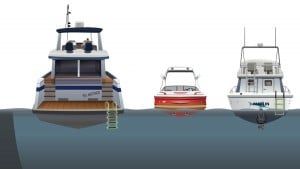BOATsmart! Study Guide Glossary:
Abaft: The direction towards the stern or near the back of the pleasure craft.
Abreast: Side by side; by the side of the craft.
Adrift: Loose, not on moorings or towline.
Aft: Towards the rear of the pleasure craft.
Aground: Touching or fast to the waterway bottom.
Ahead: The direction in front of the bow of the pleasure craft.
Amid ship: In or toward the centre of the boat.
Anchor swivel: The connector between the anchor and the anchor line
Beam: The width of a boat at its widest point.
Bilge: The lowest point on a boat.
Bow: The forward or front part of a boat.
Bow-eye: The part that the trailer winch hooks to on the boat.
Channel: A length of water wider than a strait that joins two larger areas of water.
Circle of death: This is the scenario in which a boat operator falls overboard while the engine is still running. The boat then circles back and hits the operator.
Coupler: A mechanism that is bolted or welded onto the end of a trailer tongue.
Double bottom: A compartment some boats have between the floor and hull of the boat, for safety.
Draft: The distance from the waterline to the lowest point of the hull.
Flame-tight: Secured tightly so as to be resistant to flame and preventive of explosion.
Freeboard: The height of a ship’s side between the waterline and the deck.
Gas separator: A device that removes water and solid contaminants from the fuel before it reaches the fuel pump.
Ground tackle: All of the anchor equipment including the anchor, the anchor line and the rode.
Grounded: Firmly planted on the ground, as a portable gas tank.
Hitch: Also called a tow-hitch or tow-bar, a device attached to the frame of a vehicle for towing a boat.
Inboard end: The end of the anchor line that is attached to the boat.
Intake grate: The suction area on the bottom of a PWC.
International waters: Oceans, seas, and waters outside of national jurisdiction.
Jet thrust nozzle: The part of a PWC through which water is forced to create propulsion.
Jetty: A narrow piece of land that extends into a waterway.
Lateral stability: The ability of a PWC to stay upright and not tilt sideways when crossing a wake.
Mainsail: The principal sail on a sailboat.
Non-pyrotechnic: Visual distress signals that do not ignite, such as hand signals or code flags.
Outboard end: The end of the anchor line that is attached to the anchor.
Outdrive: A power unit and attached propeller mounted at the stern of a boat, outside the hull.
Propulsion system: The source of power of a PWC, which is created by water being sucked in and propelled out.
Pyrotechnic: Igniting, as in visual distress signals that provide lighted visibility.
Rapids: A white-water area that is unsafe for boaters and especially unsafe for paddle crafts.
Rode: The line or chain attached to the anchor and secured to the boat.
Rudder: A device used to steer a boat. It may be either outboard or inboard. Outboard rudders are hung on the stern or transom. Inboard rudders are hung from a keel.
Running aground: When a boat hits shallow ground or an obstacle while underway and becomes stuck on the obstacle.
Sniff test: Using your nose to smell/detect gasoline fumes on your boat.
Trim: The forward/rear angle of the boat in the water.
Winch: A hauling or lifting device consisting of a rope or chain winding around a horizontal rotating drum.
Waterline: On the boat’s hull, this is the line at which the boat sits in the water when the boat is properly loaded with passengers and equipment.
VHF radio: Very High Frequency radio
For more information about boating terminology and boating safety check out our Knowledge Base, or to get certified with your Canadian Boating License (Pleasure Craft Operator Card) visit www.BoatSmartExam.com


